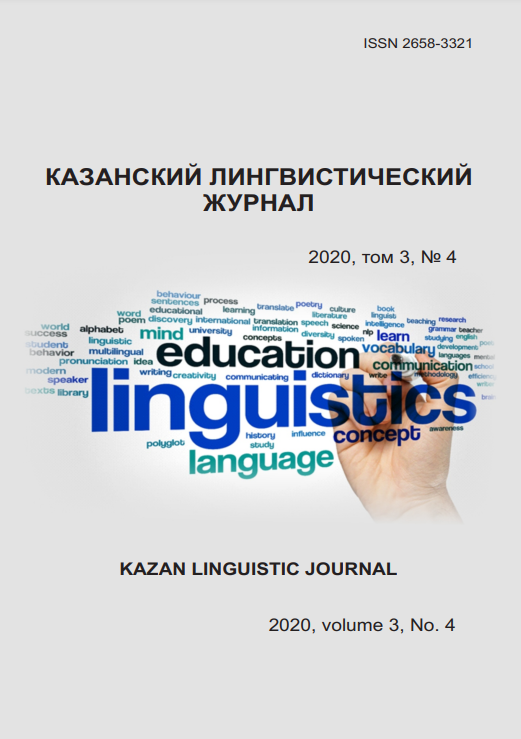Fifty shades of gray in the idiomatic of the french and tatar languages
Keywords:
linguistics, typology of multi-structural languages, phraseology, coloridomatics, French language, Tatar language, gray colorAbstract
The article provides a typological analysis of the functioning of the coloronym “gray” in such distant languages as French which belongs to the Romance group of languages, and Tatar which belongs to the Turkic language family. The relevance of the article is confirmed by an overview of linguistic studies of the concept "gray" in various languages of the world. The recency lies in the fact that comparative studies of this concept in the language pair: French-Tatar have not been conducted before. The article provides parallels and discrepancies between the concepts of "gris" and "sory" in French and Tatar. The material for this study was the majority of examples from monolingual phraseological dictionaries of the French and Tatar languages. This choice is due to the fact that phraseological units most clearly demonstrate all national features of the functioning of a particular concept in any language. This article is a logical continuation of a number of scientific works of this author who has already made a comparative analysis of such coloronyms as “blue” – “green” and “black” – “white” in the languages already mentioned. The author sees the grand result of his work as the creation of a Tatar-French phraseological dictionary which would contribute to the further diversified development of the Tatar language.
References
Литература
Василова Л.Р., Биктагирова З.А., Депутатова Н.А., Касимов О.Х. Анализ перевода фигур речи в английском, испанском и турецком языках. Opcion. 2019. С. 934–948.
Денисенко М.В. Фразеологизмы с компонентом «grey/серый» в английском и русском языках. Молодой учёный. 2016.№ 7 (111). С. 1152–1154. // URL: https://moluch.ru/archive/111/27286
Денисенко М.В. Варианты наименований и способы получения оттенков серого цвета. Молодой ученый. № 7 (30). 2016.Т. 1. С. 149–151. // URL: https://moluch.ru/archive/30/3474
Ельмслев Л. Пролегомены к теории языка. М. Серия «Лингвистическое наследие ХХ века». 2006. 248 с.
Кондратьева И., Сабирова Д.Р., Плотникова Н. Субъективные функции в рефлексивных и межкультурных процессах лингвистического развития. Cypriot Journal of Educational Sciences. 2018. Т. 13(4). С. 529 536.
Платонова Е.А. Цветонаименования на территории распространения «малых» романских языков (семантика, фразеология). Автореферат диссертации на соискание уч. ст. кандидата филологических наук. Москва, 2010. 26 с.
Поляков С.Э. Концепты и другие конструкции сознания. СПб.: Питер, 2017. 156 с.
Романович Г.А. К вопросу о специфике цветообозначений во французских и российских журналах мод. Молодой ученый. 2015. № 21 (101). С. 87–91. // URL: https://moluch.ru/archive/101/22876.
Сабирова Д.Р. и др. Понимание английского национального характера в формировании профессиональной языковой культуры. Journal of Educational and Social Research. 2019. Т. 9. Вып. 3. С. 101¬106.
Ситдыкова А.Ф. Когнитивное исследование цветового пространства в татарском языке: автореферат дис. на соискание ученой степени кандидата филологических наук. Казань, 2013. 22 с.
Berlin B., Key P. Basic Colour Terms: Their universality & evolution. Berkeley, 1969.
References
Vasilova L.R., Biktagirova Z.A., Deputatova N.A., Kasimov O.Kh. (2019). Analysis of the translation of figures of speech in English, Spanish and Turkish. Opcion. Pp. 934–948. (In Russian)
Denisenko M.V. (2016). Phraseologisms with the component “gray / seryi” in English and Russian. Molodoi uchenyi. № 7 (111). P. 1152–1154. (In Russian)
Denisenko M.V. (2011). Naming options and methods for producing shades of gray. Molodoi uchenyi. № 7 (30). Vol. 1. 149–151. (In Russian)
Hjelmslev L. (2006). Prolegomena to the theory of language. M. Series “Linguistic heritage of the twentieth century”. 248 p. (In Russian)
Kondrat'eva I., Sabirova D.R., Plotnikova N. (2018). Subjective functions in reflexive and intercultural processes of linguistic development. Cypriot Journal of Educational Sciences. Vol. 13(4). Pp. 529–536. (In English)
Platonova E.A. (2010). Color names in the territory of distribution of "small" Romance languages (semantics, phraseology). Abstract of dissertation for the degree of candidate of philological sciences. Moscow. 26 p. (In Russian)
Polyakov S.E. (2017). Concepts and other constructs of consciousness. SPb.: Piter. 156 p. (In Russian)
Romanovich G.A. (2015). On the question of the specifics of color designation in French and Russian fashion magazines. Molodoi uchenyi. № 21 (101). P. 87–91. (In Russian)
Sabirova D.R. and others (2019). Understanding the English national character in the formation of a professional language culture. Journal of Educational and Social Research. Vol. 9. 3 ed. Pp. 101–106. (In English)
Sitdykova A.F. (2013). Cognitive research of color space in the Tatar language: Abstract of dissertation for the degree of candidate of philological sciences. Kazan'. 22 p. (In Russian)
Berlin B., Key P. (1969). Basic Colour Terms: Their universality & evolution. Berkeley. (In English)






